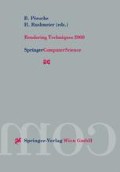Abstract
This paper presents weighted importance sampling techniques for Monte Carlo form factor computation and for stochastic Jacobi radiosity system solution. Weighted importance sampling is a generalisation of importance sampling. The basic idea is to compute a-posteriori a correction factor to the importance sampling estimates, based on sample weights accumulated during sampling. With proper weights, the correction factor will compensate for statistical fluctuations and lead to a lower mean square error. Although weighted importance sampling is a simple extension to importance sampling, our experiments indicate that it can lead to a substantial reduction of the error at a very low additional computation and storage cost.
Access this chapter
Tax calculation will be finalised at checkout
Purchases are for personal use only
Preview
Unable to display preview. Download preview PDF.
References
J. Arvo. Stratified sampling of spherical triangles. In Computer Graphics Proceedings, Annual Conference Series, 1995 (ACM SIGGRAPH ’95 Proceedings), pages 437–438, August 1995.
D. R. Baum, H. E. Rushmeier, and J. M. Winget. Improving radiosity solutions through the use of analytically determined form-factors. In Computer Graphics (SIGGRAPH ’89 Proceedings), volume 23, pages 325–334, July 1989.
Ph. Bekaert. Hierarchical and Stochastic Algorithms for Radiosity. PhD thesis, Katholieke Universiteit Leuven, December 1999.
Ph. Bekaert, L. Neumann, A. Neumann, M. Sbert, and Y. D. Willems. Hierarchical Monte Carlo radiosity. In Rendering Techniques ’98 (Proceedings of the 9th. Eurographics Workshop on Rendering), pages 259–268. June 1998.
F. Castro, R. Matinez, and M. Sbert. Quasi-Monte Carlo and extended first-shot improvement to the multi-path method. In Proc. Spring Conference on Computer Graphics ’98, pages 91–102, Bratislava, Slovakia, April 1998. Comenius University.
M. H. Kalos and P. Whitlock. The Monte Carlo method. J. Wiley and sons, 1986.
L. Neumann. Monte Carlo radiosity. Computing, 55(1):23–42, 1995.
L. Neumann, A. Neumann, and Ph. Bekaert. Radiosity with well distributed ray sets. Computer Graphics Forum, 16(3):C261–C270, 1997. Proceedings of Eurographics ’97.
L. Neumann, W. Purgathofer, R. Tobler, A. Neumann, P. Elias, M. Feda, and X. Pueyo. The stochastic ray method for radiosity. In P. Hanrahan and W. Purgathofer, editors, Rendering Techniques ’95 (Proceedings of the Sixth Eurographics Workshop on Rendering), July 1995.
S. N. Pattanaik and S. P. Mudur. Computation of global illumination by Monte Carlo simulation of the particle model of light. Proceedings of the Third Eurographics Workshop on Rendering, pages 71–83, May 1992.
M. J. D. Powell and J. Swann. Weighted uniform sampling — a Monte Carlo technique for reducing variance. J. Inst. Maths. Applics., 2:228 – 236, 1966.
M. Sbert. An integral geometry based method for fast form-factor computation. Computer Graphics Forum, 12(3):C409–C420, 1993.
M. Sbert. The use of global random directions to compute radiosity — Global Monte Carlo techniques. PhD thesis, Universitat Politècnica de Catalunya, Barcelona, Spain, November 1996.
J. Spanier. A new family of estimators for random walk problems. Journal of the Institute of Mathematics and its Applications, 23:1–31, 1979.
J. Spanier and E. H. Maize. Quasi-random methods for estimating integrals using relatively small samples. SIAM Review, 36(1): 18–44, March 1994.
L. Szirmay-Kalos and W. Purgathofer. Global ray-bundle tracing with hardware acceleration. In Rendering Techniques ’98 (Proceedings of the 9th. Eurographics Workshop on Rendering), pages 247 – 256. June 1998.
E. Veach and L. J. Guibas. Optimally combining sampling techniques for Monte Carlo rendering. In SIGGRAPH 95 Conference Proceedings, pages 419–428, August 1995.
Author information
Authors and Affiliations
Editor information
Editors and Affiliations
Rights and permissions
Copyright information
© 2000 Springer-Verlag Wien
About this paper
Cite this paper
Bekaert, P., Sbert, M., Willems, Y.D. (2000). Weighted Importance Sampling Techniques for Monte Carlo Radiosity. In: Péroche, B., Rushmeier, H. (eds) Rendering Techniques 2000. EGSR 2000. Eurographics. Springer, Vienna. https://doi.org/10.1007/978-3-7091-6303-0_4
Download citation
DOI: https://doi.org/10.1007/978-3-7091-6303-0_4
Published:
Publisher Name: Springer, Vienna
Print ISBN: 978-3-211-83535-7
Online ISBN: 978-3-7091-6303-0
eBook Packages: Springer Book Archive

